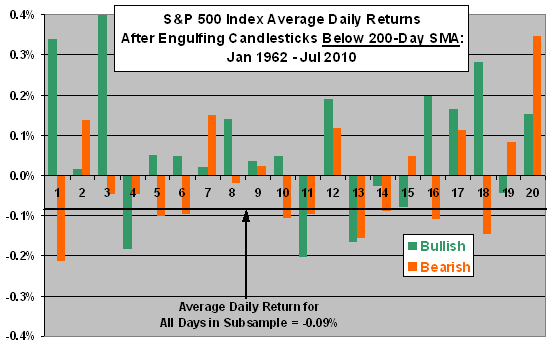A reader inquired about the predictive powers of bullish and bearish engulfing candlesticks, defined as: Bullish – a down day followed by an up day, with the latter having a higher intraday high and lower intraday low and closing in the top quarter of the daily range; and, Bearish – an up day followed by a down day, with the latter having a higher intraday high and lower intraday low and closing in the bottom quarter of the daily range. Using daily high, low and closing levels for the S&P 500 Index from January 1962 (the earliest available with intraday data) through July 2010, we find that:
There are 186 (184) bullish (bearish) engulfing candlesticks for the S&P 500 Index during the overall sample period. Since the beginning of 1990, there are 106 (106) bullish (bearish) engulfing candlesticks.
The following two charts show the average daily (close-to-close) returns for the 20 trading days after engulfing candlesticks for the entire sample period and the subperiod since 1990. The average daily return for all trading days for both is 0.03%. Results suggest that:
- The two patterns appear to deserve their bullish and bearish designations for the first trading day after formation (assuming a trader could identify pattern completion just before the close and trade at the close accordingly). However, the indications are much weaker in the recent subperiod.
- Over the balance of the 20-day horizon, there is no clear persistence of the first-day reaction. The averages of the average daily returns across all 20 trading days after bullish (bearish) engulfing candlesticks are 0.04% and 0.03% (0.03% and 0.04%) for the entire sample period and the recent subperiod, respectively.
Given the fairly small size of any abnormalities, standard deviations of daily returns that are much larger than any abnormalities (in the range of 1% to 2%) and the rareness of signals, it seems unlikely that a trader could materially exploit these results on a net basis.
To check the effect of market trend, we look separately at times when the S&P 500 Index is above or below its 200-day simple moving average (SMA).


The next two chart show the average daily (close-to-close) returns for the 20 trading days after engulfing candlesticks when the S&P 500 Index is above or below its 200-day SMA over the entire sample period. The index is above its 200-day SMA about 68% of the time. The average daily return for trading days when the index is above (below) its 200-day SMA is 0.09% (-0.09%). Results suggest that:
- Again, the two patterns appear to deserve their bullish and bearish designations for the first trading day after formation (assuming a trader could identify pattern completion just before the close and trade at the close accordingly). The indications are stronger when the index is below its 200-day SMA.
- Over the balance of the 20-day horizon, it appears that the bearish engulfing candlestick may be persistently bullish (somewhat persistently bearish) when the index is above (below) its 200-day SMA.
- The averages of the average daily returns across all 20 trading days after bullish (bearish) engulfing candlesticks are 0.03% and 0.07% (0.05% and -0.01%) when the index is above and below its 200-day SMA, respectively.
Note that standard deviations of daily returns tend to be relatively small (large) when the index is above (below) its 200-day SMA.
Again, given the fairly small size of any abnormalities, standard deviations of daily returns that are much larger than any abnormalities and the rareness of signals, it seems unlikely that a trader could materially exploit these results on a net basis.
For a different perspective, we look at cumulative index returns over three intervals after engulfing candlesticks.


The final pair of charts summarize average cumulative returns during three intervals after bullish and bearish engulfing candlesticks for four cases: all instances since 1962; all instances since 1990; instances while the S&P 500 Index is above its 200-day SMA since 1962; and, instances while the index is below its 200-day SMA since 1962. Results suggest that
- Inconsistencies between the full sample period and the recent subperiod undermine belief in the significance of the bullish engulfing candlestick.
- The bullish engulfing candlestick may present an attractive long-side trade while the index is below, but probably not above, its 200-day SMA. There are 65 instances of this combination since 1962 (about 1.3 per year). Since 1990, the returns for the 34 instances of this combination are notably weaker than those depicted.
- After waiting a day, the bearish engulfing candlestick may present an attractive long-side trade while the index is above, but not below, its 200-day SMA. However, the margin over buying and holding the index is relatively small in this case. There are 123 instances of this combination since 1962 (about 2.5 per year). The strength of returns persists in the 70 instances since 1990.


Note that considering more and more rules and combinations of rules for the same data elevates data snooping bias (luck) in results.
In summary, given the fairly small size of any abnormalities, standard deviations of returns that are much larger than any abnormalities and the rareness of signals, it seems unlikely that a trader could materially exploit bullish and bearish engulfing candlesticks for the S&P 500 Index at the portfolio level.